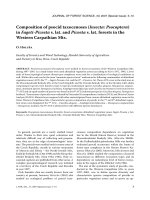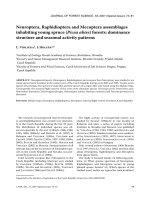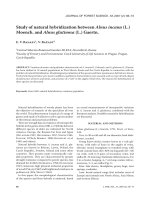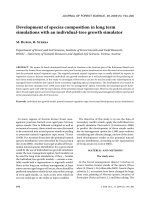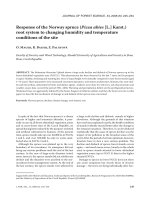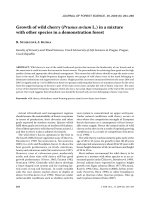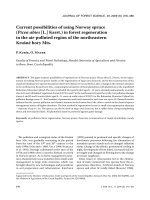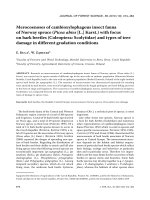Báo cáo lâm nghiệp: "Merocoenoses of cambioxylophagous insect fauna of Norway spruce (Picea abies [L.] Karst.) with focus on bark beetles (Coleoptera: Scolytidae) and types of tree damage in different gradation conditions" ppsx
Bạn đang xem bản rút gọn của tài liệu. Xem và tải ngay bản đầy đủ của tài liệu tại đây (138.66 KB, 11 trang )
474 J. FOR. SCI., 56, 2010 (10): 474–484
JOURNAL OF FOREST SCIENCE, 56, 2010 (10): 474–484
Supported by Ministry of Agriculture of the Czech Republic, Project No. 1G46001, and by the Ministry of Education,
Youth and Sports of the Czech republic, Project No. MSM 6215648902, and by the Foundation ČEZ SME/13/09
Merocoenoses of cambioxylophagous insect fauna
of Norway spruce (Picea abies [L.] Karst.) with focus
on bark beetles (Coleoptera: Scolytidae) and types of tree
damage in diff erent gradation conditions
E. K
1
, W. Z
2
1
Faculty of Forestry and Wood Technology, Mendel University in Brno, Brno, Czech Republic
2
Faculty of Forestry, Agricultural University of Cracow, Cracow, Poland
ABSTRACT: Research on merocoenoses of cambioxylophagous insect fauna of Norway spruce (Picea abies [L.]
Karst.) was carried out in spruce stands of different age in the area with an endemic population (Moravian-Silesian
Beskids, Czech Republic) and in the area with an epidemic population (Beskid Żywiecki, Poland) of the eight-toothed
spruce bark beetle Ips typographus (L.). The structure of merocoenoses was characterized separately for standing
trees attacked by bark beetles, trees struck by lightning, trees affected by fungal pathogens and wind-felling and trees
in the form of snags and fragments. The occurrence of cambioxylophagous insects, mostly bark beetles (Coleoptera:
Scolytidae), was compared between the study areas with emphasis on dominant facultative primary bark beetles and
types of damage to spruce trees.
Keywords: bark beetles; the Beskids; Central Europe; merocoenoses; Norway spruce, Picea abies; tree damage
lineatus (Oliv.), a technical pest of spruce, is most
important.
Like other forest tree species, Norway spruce is
a host for bark beetles (Scolytidae) and numerous
other representatives of cambioxylophagous insect
fauna (P 1955) which co-exist in species and
space specifi c merocoenoses. P (1932, 1955),
C (1978) and Z (1984) characterized the
merocoenosis of bark beetle associates of Norway
spruce in Central Europe. e merocoenosis struc-
ture depends on the habitat and habitat require-
ments of particular bark beetle species which refl ect
their biology, ecology and behaviour at particular
sites and in particular areas. erefore it is impos-
sible to set the exact limits for the occurrence of bark
beetles in spruce stems and branches. Some bark
beetle species may develop together (e.g. I. typogra-
phus × P. chalcographus, I. amitinus × P. chalcogra-
phus), whereas the habitats of other species show
e bark beetle fauna of the Central and Western
Palaearctic region consists of a total of 308 species
and 53 genera. A total of 56 bark beetle species feed
on Picea spp., and a total of 39 species depend on
Norway spruce as their host (P 1995). Of a
total of 111 bark beetle species known to occur in
the Czech Republic (P, K 1993), a to-
tal of 31 species are the associates of Norway spruce
(Picea abies [L.] Karst.) (P 1995). K
(2004) reported the danger of spreading new spe-
cies of bark beetles.Regarding the distribution of
bark beetles and their ability to attack and kill also
living spruce trees the following several species are
economically important: Ips typographus (L.), Ips
amitinus (Eich.), Ips duplicatus (Sahl.), Pityogenes
chalcographus (L.), Pityophthorus pityographus
(Ratz.) and Polygraphus poligraphus (L.). Among
temporal secondary species, which do not attack
living trees, the ambrosia bark beetle Xyloterus
J. FOR. SCI., 56, 2010 (10): 474–484 475
only slight overlap (I. typographus × I. amitinus) or
no overlap at all (I. typographus × P. poligraphus).
Orientation to attractants (W 1982), social
position of a tree (K, Z 1997a), tree age,
phloem and bark quality (P 1975; G
1986; K, Z 2001, 2002), meso- and mi-
croclimate, the process of tree dieback and its dura-
tion, predisposition of a tree to bark beetle attack
(S 1955; K, Z 2001),
species gradology (B et al. 1977), intensity of
physiologically or mechanically acting stress fac-
tors such as fungal tree pathogens (K
1978; C, H 1980; K, Z
1999a, 1999b), drought (R ; R,
V 1972; M et al. 2005), lightning stroke
(B 2005; K, Z 1997b, 2007), air
pollution (K, W 1963), wind and snow
(S et al. 1998, W et al. 2002,
K, Z 2004) rank among the key factors
aff ecting the occurrence and population densities
of bark beetles on Norway spruce.
e study aims to evaluate the position (occur-
rence, role) of economically important bark beetles
in the merocoenosis of cambioxylophagous insect
fauna associated with stems of standing spruce
trees attacked by bark beetles, in the merocoeno-
sis of trees aff ected by fungal tree pathogens, light-
ning and wind-felling, and in the merocoenosis of
snags and fragments (tree parts), in spruce stands
of diff erent age and in diff erent situations with re-
gard to the occurrence and population dynamics of
I. typographus.
MATERIAL AND METHODS
Data on cambioxylophagous insect fauna asso-
ciated with diff erent types of spruce damage were
collected in study plots situated in spruce stands
of the Šance reservoir in the Moravian-Silesian
Beskids, Czech Republic, over the period 1994 to
2007. Simultaneously, research was carried out in
study plots located in spruce stands of the Beskid
Żywiecki, Poland, between 2004 and 2007 (K,
Z 2003; K, K 2005). e study
plots in the Czech Republic and Poland markedly
diff er from each other by the occurrence of I. ty-
pographus (see below).
According to methods and approaches employed
in the study (for more information see K,
Z 1996a, 1996b), damage to phloem by
cambioxylophagous insect fauna (mostly by bark
beetles) was documented in the area with an en-
demic (low) population of Ips typographus – en-
demic situation (Forest District Ostravice, CR) by
evaluating a total of 1,536 spruce stems, the total
length of which was 44,396 m. Of this, a total of
826 stems (21,853 m long altogether) were standing
trees attacked by bark beetles, 194 stems (6,751m)
were trees struck by lightning, 140 stems (4,667m)
were trees affl icted by wind-felling (windfalls), 100
stems (5,202 m) were trees in the form of snags
and fragments in mature spruce stands, 276 stems
(5,923 m) were trees in the form of snags and frag-
ments in pole-stage stands. e area was character-
ized by a small proportion (0.5–2%) of bark beetle
salvage felling over the period 2001–2007.
Further, a total of 496 spruce stems (16,188 m)
were checked for the presence of cambioxylopha-
gous insect fauna in the area with an epidemic
(high) population of Ips typographus – epidemic sit-
uation (Forest District Ujsoly, Jelesnia, Poland). In
this particular area, a total of 381 stems (12,010m
long altogether) were the standing trees attacked
by bark beetles, followed by 80 stems (2,854 m) of
wind-felled trees, 35 stems (1,324 m) were checked
in the form of snags and tree fragments (tree parts).
A high proportion (37–97%) of annual bark beetle
salvage felling in the area between 1993 and 2007
was typical.
RESULTS
A total of 34 species of cambioxylophagous fauna
of spruce were recorded over the study period: Bu-
prestidae (l), Cerambycidae (9), Curculionidae (2),
Lymexylonidae (1), Scolytidae (18), Formicidae (1)
and Siricidae (2 species). In the species spectrum
the following trophic groups were distinguished:
xylophages (3), cambioxylophages (8), myceto-
phages (2) and cambiophages (21 species). ey
were categorized as facultative primary pests (10),
latent secondary pests (8) and temporal secondary
pests (16 species).
Merocoenoses of cambioxylophagous insects
with regard to the social position of a tree
In the study area with an endemic population
of I. typographus (non-epidemic situation) a con-
tinuous decline of the frequency of occurrence of
I. typographus, and X. lineatus from dominant to
subordinate trees was documented. Bark beetle
species preferring dominant and co-dominant trees
to subordinate ones (P. chalcographus, I. amitinus),
and also species attacking particularly dominant
trees (Hylurgops palliatus /Gyll./), rank among
cambioxylophages. Subordinate trees were more
frequently colonized by Xylechinus pilosus (Ratz.),
476 J. FOR. SCI., 56, 2010 (10): 474–484
Table 1. Frequency of occurrence of some cambioxylophagous insects in standing trees related to the social position
of a tree (%)
Population density Endemic situation Epidemic situation
Social position
of a tree
D CoD ST D CoD ST D CoD ST D CoD ST
Scolytidae N (%) N (%)
I. typographus 83 56 6 43.4 25.5 2.0 100 92 77 58.8 51.6 38.9
I. amitinus 70 63 23 16.0 15.9 6.8 73 69 74 22.1 23.2 24.9
P. chalcographus 92 82 45 42.5 43.3 24.2 95 93 92 38.2 47.1 51.2
P. poligraphus 32 45 55 9.8 19.0 24.4 26 13 28 7.6 4.5 9.2
P. pityographus 62 61 75 4.3 5.0 12.8 17 21 44 0.7 1.2 3.3
C. abietis 11 9 18 0.8 0.6 2.1 0 0 0 0 0 0
X. lineatus 43 24 12 10.2 6.3 2.8 3 2 3 0.6 0.4 0.2
H. palliatus 34 23 23 8.0 5.8 5.7 6 5 3 1.0 0.8 0.2
X. pilosus 4 4 21 0.1 0.4 4.7 0 0 3 0 0 0.1
D. autographus 9 6 5 0.8 0.6 0.8 0 0 0 0 0 0
P. spinulosus 26 34 44 0 0 0.2 0 0 1 0 0 0
Curculionidae
P. harcyniae 11 13 22 2.3 2.9 5.5 2 1 4 0.1 0.2 0.3
Cerambycidae
M. minor 26 33 49 1.6 2.6 17.2 0 1 8 0 0.2 1.8
I. fuscum 26 27 5 3.2 4.2 0.6 9 5 5 2.1 0.5 0.5
R. inquisitor 36 24 22 3.0 2.1 1.7 6 3 3 0.6 0.4 0.1
Monochamus sp. 2 3 0 0.3 0.4 0 2 4 0 0.2 0.5
O. brunneum 25 26 25 0 0.2 1.4 0 1 0 0 0 0
P. fasciculatus 6 12 17 0.2 0.2 0.9 0 0 1 0 0 0
Number of trees 53 247 525 66 237 78
Number of
sections (m)
1,709 6,995 13,115 2,420 7,485 2,105
D – dominant, CoD – co-dominant, ST – subordinate tree, N – number of individuals
P. poligraphus (Scolytidae), Molorchus minor (L.),
Pogonocherus fasciculatus (De Geer) (Cerambyci-
dae) and Pissodes harcyniae /Herbst/) (Curculioni-
dae) (Table 1).
e merocoenosis structure of cambioxylophag-
es in standing trees in the area with an epidemic
population of I. typographus (epidemic situation)
was partly aff ected by a decrease in tree density
(lower stocking). e eff ect of the social position
of a tree, documented by the frequency of occur-
rence of particular species, was not evident in
P. chalcographus and I. amitinus. In the case of
subordinate trees, the frequency of occurrence of
I. typographus was lower (compared to dominant
and co-dominant trees), whereas in Pityophthorus
pityographus (Ratz.) it was higher (Table 1).
In the study area with an endemic population
of I. typographus the cover (exploitation) of stems
by cambioxylophages markedly decreased only in
subordinate trees (P. chalcographus, I. amitinus)
or was lowering continuously from dominant trees
(I. typographus, X. lineatus). Diff erent response was
seen in species preferring subordinate trees. eir
attack was increasing continuously (P. poligraphus)
or became more evident only in subordinate trees
(P. pityographus, M. minor) (Table 1).
In the area with an epidemic population of
I. typographus, only P. chalcographus occurred
J. FOR. SCI., 56, 2010 (10): 474–484 477
frequently on co-dominant and subordinate trees.
P. poligraphus and I. amitinus did not respond to
the social position tree of a tree by the stem cover
(exploitation) and a decrease in the population of
I. typographus was evident in subordinate trees
only (Table 1).
Merocoenoses of cambioxylophagous insects
in standing trees attacked by bark beetles
e study area with an endemic population of
I. typographus was characterized by high species
richness and diversity of cambioxylophagous and
wood-inhabiting insects (33), but only 18 species
were more abundant. Considering the frequency
of occurrence of cambioxylophagous insects in
standing trees attacked by bark beetles, the fre-
quencies exceeding 50% were found in the case of
P. pityographus (69.7%), P. chalcographus (59.1%)
and P. poligraphus (50.2%). Frequencies in the range
of 25–50% were found in fi ve species, of which I. ty-
pographus (26.3%) and I. amitinus (37.8%) were ec-
onomically important (facultative primary pests).
Frequencies ranging from 10 to 25% were docu-
mented in eight species (Table 2).
In the area with an endemic population of I.
typographus, species richness was much lower
(18 species). e highest frequency of occur-
rence was found in P. chalcographus (93.2%), I. ty-
pographus (90%) and I. amitinus (70.6%). Only P.
pityographus (24.7%) and P. poligraphus (18.1%),
the two species which do not occur together with
Ips typographus under spruce bark and thus do not
compete with it, ranked among relatively frequent
accompanying species (Table 2).
Standing trees struck by lightning in the area
with an endemic population of I. typographus were
characterized by a specifi c merocoenosis in which
Table 2. Frequency of occurrence of some cambioxylophagous insects (three categories) in spruce stems depending
on stem damage and gradation conditions of Ips typographus (%)
Species/
Type of damage
Endemic situation Epidemic situation
bark-
beetles
lightning windfall
stem
breaks-snags
broken-off
part
(fragments)
sum
bark-
beetles
windfall
stem
breaks-
snags
broken-off
part
(fragments)
Facultative-primary
I. typographus 26.3 35.7 66.4 1.0 27.7 32.7 90.0 98.8 2.9 91.4
I. amitinus 37.8 59.7 32.9 1.0 15.8 40.9 70.6 43.8 0.0 74.3
P. chalcographus 59.1 86.2 88.6 4.0 66.3 67.2 93.2 91.3 0.0 97.1
P. poligraphus 50.2 83.7 10.7 34.3 38.6 51.1 18.1 0.0 0.0 0.0
P. pityographus 69.7 40.3 16.4 0.0 32.7 58.3 24.7 1.3 0.0 2.9
C. abietis 14.6 4.1 4.3 0.0 19.8 11.6 0.3 0.0 0.0 0.0
P. harcyniae 19.1 4.6 7.2 11.1 9.9 15.2 1.8 0.0 0.0 0.0
Number of trees
826 196 140 99 101 1,162 381 80 35 35
Temporal-secondary
X. lineatus 17.6 63.8 11.4 27.3 2.0 24.6 2.4 1.3 37.1 0.0
H. palliatus 23.6 74.5 39.3 20.2 30.7 34.1 4.5 11.3 20.0 45.7
X. pilosus 14.4 0.5 0.0 0.0 0.0 10.3 0.5 0.0 0.0 0.0
D. autographus 5.2 2.0 9.3 9.1 4.0 5.2 0.0 3.8 0.0 0.0
M. minor 42.7 11.7 2.1 0.0 1.0 32.6 2.1 0.0 0.0 0.0
I. fuscum 13.0 28.6 25.7 22.2 5.0 17.1 5.5 1.3 0.0 0.0
R. inquisitor 23.1 9.2 0.7 4.0 3.0 18.1 3.4 1.3 0.0 0.0
Monochamus sp. 2.9 2.6 22.1 5.1 20.8 7.2 2.1 30.0 0.0 0.0
Number of trees
826 196 140 99 101 1,162 381 80 35 35
Latent-secondary
P. spinulosus 40.1 13.8 3.6 0.0 0.0 31.2 0.3 0.0 0.0 28.6
O. brunneum 25.2 8.7 0.7 0.0 0.0 19.4 0.5 0.0 0.0 0.0
P. fasciculatus 14.9 2.0 2.1 0.0 3.0 11.2 0.3 0.0 0.0 0.0
Number of trees 826 196 140 99 101 1,162 381 80 35 35
478 J. FOR. SCI., 56, 2010 (10): 474–484
facultative primary species like P. chalcographus,
P. poligraphus and I. amitinus played the most
important roles (see the high frequency of occur-
rence), whereas the importance of I. typographus
only slightly increased as compared to standing
trees not aff ected by lightning (Table 2).
As for temporal secondary species, the frequen-
cy of occurrence of X. lineatus on standing trees
greatly increases in trees aff ected by lightning
stroke (Table 2). Changes in wood moisture and
the rate of tree dieback suit the ecological require-
ments of the ambrosia bark beetle. It attacks trees
struck by lightning which can have green crowns
showing no visible signs of dying. Also, H. palliatus
preferred the fermented moist phloem of trees af-
fected by lightning (Table 2).
In the case of standing trees killed by cambioxy-
lophagous insect species in the area with an endem-
Table 3. Stem cover of some cambioxylophagous insects (three categories) depending on stem damage and gradation
conditions of Ips typographus (%)
Species/
Type of damage
Endemic population Epidemic population
bark-
beetles
lightning windfall
stem
breaks-snags
broken-off
part
(fragments)
sum
bark-
beetles
windfall
stem
breaks-
snags
broken-off
part
(frag-
ments)
Facultative-primary
I. typographus 12.8 8.8 29.7 0.1 20.0 14.37 50.84 60.16 2.04 65.3
I. amitinus 10.4 9.5 3.5 0.2 2.9 9.28 23.26 8.20 0 15.8
P. chalcographus 31.8 25.7 32.1 2.9 43.6 30.60 46.01 23.93 0 23.8
P. poligraphus 21.5 36.0 2.4 27.7 16.4 21.75 5.92 0 0 0
P. pityographus 9.6 2.1 0.7 0 3.8 6.83 1.47 0.25 0 0.1
C. abietis 1.5 0.1 0.1 0 1.8 1.00 0 0 0 0
P. harcyniae 4.5 0.4 0.7 5.1 0.9 3.25 0.22 0 0 0
Number of
sections (m)
21,853 6,751 4,667 1,030 1,831 33,271 12,010 2,854 49 1,275
Temporal-secondary
X. lineatus 4.5 15.3 5.4 6.6 0.9 6.79 0.41 0.77 26.53 4.1
H. palliatus 5.9 20.5 15.2 6.0 11.4 10.20 0.71 2.52 14.29 9.2
X. pilosus 2.9 0.0 0.0 0 0 1.93 0.02 0 0 0
D. autographus 0.7 0.1 2.5 3.0 1.4 0.85 0 0.35 0 0
M. minor 11.3 0.2 0.0 0 0.1 7.48 0.42 0 0 0
I. fuscum 2.1 4.4 4.4 7.0 1.7 2.87 0.74 0.11 0 0
R. inquisitor 1.9 1.4 0.0 0.4 0.3 1.54 0.40 0.07 0 0
Monochamus sp. 0.3 0.3 7.6 1.7 6.7 1.27 0.21 7.95 0 0
Number of
sections (m)
21,853 6,751 4,667 1,030 1,831 33,271 12,010 2,854 49 1,275
Latent-secondary
P. spinulosus 00 0 0 000000
O. brunneum 0.9 0 0 0 0 0.57 0.02 0 0 0
P. fasciculatus 0.6 0 0 0 0.2 0.42 0 0 0 0
Number of
sections (m)
21,853 6,751 4,667 1,030 1,831 33,271 12,010 2,854 49 1,275
J. FOR. SCI., 56, 2010 (10): 474–484 479
ic population of I. typographus, the major part of a
stem was exploited by P. chalcographus (32%) and
P. poligraphus (21.5%), followed by relatively low
densities of I. typographus, I. amitinus, P. pityogra-
phus and M. minor (10–13%). e temporal second-
ary species X. lineatus and H. palliatus (4.5–6%)
were of marginal importance (Table 3). In the area
with an epidemic population of I. typographus,
standing trees were heavily colonized by I. typogra-
phus (51%), P. chalcographus (46%) and I. amitinus
(23%) (Table 3). e magnitude of colonization was
approaching the carrying capacity of trees.
In the case of trees struck by lightning in the
area with an endemic population of I. typographus,
P. poligraphus (36%) and P. chalcographus (26%)
were most important with regard to the magni-
tude of stem cover, whereas I. typographus (9%) and
I. amitinus (9.5%) were less important. On the other
hand, a marked response occurred in temporal sec-
ondary pests H. palliatus (20.5%) and X. lineatus
(15%) (Table 3).
Merocoenoses of cambioxylophagous insects
aff ected by fungal tree pathogens
e fungal tree pathogens Armillaria spp. and Hete-
robasidion annosum Fr. represent important biotic
stress factors aff ecting spruce health. In the area of the
Šance reservoir, 27.2% of trees checked for the pres-
ence of cambioxylophagous insects were attacked by
Armillaria spp., 17.7% by H. annosum and 33.9% by
both pathogens (N = 825 trees colonized by bark bee-
tles). Interestingly, a much lower proportion of fungal
pathogens was found in trees aff ected by lightning
(H. annosum – 14%, Armillaria spp. – 4%, N = 194).
e trees not attacked by fungi typically hosted
facultative primary species (P. chalcographus, I. ty-
pographus and I. amitinus) and also temporal sec-
ondary species (X. lineatus) (Table 4). Fungal tree
pathogens supported the presence of some cambi-
oxylophagous insects in the study area. For exam-
ple, the trees infested by Armillaria spp. showed
the highest frequency of occurrence of P. pityogra-
Table 4. e frequency of occurrence and stem cover of some cambioxylophagous insects (%) in standing spruce trees
non-infested and infested by fungal pathogens in the area of Forest District Ostravice.
Cambioxylophage/
Pathogen
Frequency of occurrence Stem cover
0 Am Ha A+H 0 Am Ha A+H
Scolytidae
C. abietis 8.3 16.4 14.5 17.1 3.0 4.3 5.7 4.6
D. autographus 0.0 0.0 0.0 0.0 0.8 0.4 0.7 1.0
H. palliatus 26.8 21.1 24.1 23.5 6.2 6.2 6.3 5.4
I. amitinus 52.4 36.2 35.9 31.3 11.2 10.9 9.7 10.0
I. typographus 58.9 15.1 25.5 16.4 31.8 6.5 11.3 7.1
P. chalcographus 76.2 56.9 53.1 53.7 35.9 31.9 31.0 29.6
P. pityographus 60.1 79.7 57.9 73.3 5.6 11.9 7.9 11.0
P. poligraphus 34.5 50.9 48.3 60.1 12.8 21.6 22.5 26.2
P. spinulosus 29.8 38.8 43.4 45.6 0.0 0.0 0.0 0.0
X. lineatus 27.4 17.2 16.6 12.5 5.7 5.2 4.8 3.0
X. pilosus 7.7 21.1 11.7 14.2 2.0 4.6 2.2 2.6
Curculionidae
P. harcyniae 13.7 19.4 20.0 19.2 0.0 0.0 0.0 0.0
Cerambycidae
I. fuscum 23.2 7.3 15.9 10.0 3.2 0.9 2.7 2.1
M. minor 29.8 46.1 38.6 49.8 6.5 16.3 9.1 11.3
Monochamus sp. 0.0 1.3 0.7 0.0 0.2 0.2 0.3 0.4
O. brunneum 20.2 25.9 19.3 30.6 0.0 0.0 0.0 0.0
P. fasciculatus 12.5 15.5 13.8 16.4 0.0 0.0 0.0 0.0
R. inquisitor 24.4 18.5 24.1 25.6 2.0 1.4 2.2 2.1
Number of sections
(m)
4,601 6,118 3,615 7,519
Number of trees 168 232 145 281
0 – healthy trees, Am – Armillaria sp., Ha – Heterobasidion annosum, A+H – the concurrence of pathogens
480 J. FOR. SCI., 56, 2010 (10): 474–484
phus, whereas the trees free of pathogenic fungi or
infested by H. annosum only hosted a smaller but
still remarkable proportion of the species (Table 4).
P. poligraphus also attacked trees infested by tree
pathogenic fungi more often than uninfested trees.
M. minor and C. abietis showed identical responses
(Table 4).
e supportive eff ects of fungal tree pathogens
on tree colonization by bark beetles were not evi-
dent in the case of P. chalcographus, I. amitinus
and X. lineatus. However, both P. pityographus and
P. poligraphus exploited a broader niche in trees
stressed by pathogenic fungi compared to those
without these fungi. In the trees infested by Armil-
laria spp. the niche width was extremely narrowed,
particularly in the case of I. typographus (Table 4).
Merocoenoses of cambioxylophagous insects
in wind-felled trees, breaks and fragments
e trees felled by the wind in autumn were
checked for the presence of cambioxylophagous in-
sects in next spring and autumn. Merocoenoses of
cambioxylophagous insects in wind-felled trees in
the area with an endemic population of I. typogra-
phus diff ered from those in standing trees. Among
the species P. chalcographus (88.6%) and I. typogra-
phus (66.4%) were the most frequent. I. amitinus
(32.9%) and the two temporal secondary represen-
tatives, H. palliatus (39.3 %) and the long-horned
beetle I. fuscum (25.7%), were also relatively fre-
quent (Table 2). Interestingly, lower tree attack was
documented in X. lineatus, contrasting with the
high frequency of occurrence of Monochamus spe-
cies (Cerambycidae) (Table 2).
In the area with an epidemic population of I. ty-
pographus, much lower species richness was found
(10 species recorded). e species composition
refl ected the presence of insect species typical of
wind-felled trees. Two species may be considered
as widely distributed, namely I. typographus (99%)
and P. chalcographus (91%). A relatively high fre-
quency of occurrence was also found in I. amitinus
(44%) and
Monochamus species (30%) (Table 2).
ere are other special habitats of subcortical in-
sect species in spruce forests. ey are snags (stand-
ing, partly or completely dead trees, often missing the
top or most of smaller branches) and tree fragments
usually resulting from frequent wind and snow distur-
bances, mostly in autumn and winter. In the area with
an endemic population of I. typographus, the mero-
coenosis of cambioxylophagous insects in snags was
rather poor than rich. e facultative primary spe-
cies, P. poligraphus (34%), gained from these specifi c
conditions (the phloem retaining high water content,
gradually dying). e relatively high frequency of oc-
currence of the temporal secondary species X. linea-
tus (27.3%), I. fuscum (22.2%) and H. palliatus (20.2%)
cannot be overlooked (Table 2).
Wood fragments originating from snagged trees
apparently showed diff erences in the frequency of
attack by cambioxylophagous insects and in mero-
coenosis structure. In the area with an endemic
population of I. typographus, a total of 15 species
were recorded in fragments, of which the high fre-
quency of occurrence of P. chalcographus (66.3%)
and other species developing in the upper parts of
stems and branches (P. pityographus, I. amitinus,
C. abietis) was typical (Table 2). I. typographus was
frequently found in long fragments. Similarly like
in snags, P. poligraphus, H. palliatus and Monocha-
mus sutor (L.) also occurred in tree fragments on
the forest fl oor (Table 2).
In the area with an epidemic population of I. ty-
pographus, a total of 35 snags and fragments hosted
a total of 6 species of cambioxylophagous insects.
Low snags (up to 2 m high) supported three spe-
cies only. X. lineatus (37%) and H. palliatus (20%)
were the most frequent representatives of temporal
secondary species in snags. In very long fragments
a merocoenosis was established near the standing
and wind-felled trees, P. chalcographus (97.1%),
I. typographus (91.4%) and I. amitinus (74.3%)
being the most frequent species. e records of
H.palliatus (45.7%) were also frequent (Table 2).
e attractiveness of wind-felled trees for cam-
bioxylophages diff ered from that of standing trees
by the extent of stem cover (exploitation) by par-
ticular species. In the area with an endemic popula-
tion of I. typographus, the exploitation of stems by
I. typographus and P. chalcographus was balanced
(30–32%). e stem cover was 15% in the case of H.
palliatus and almost 8% in the case of Monochamus
species (temporal secondary species). However, in
the area with an epidemic population of I. typogra-
phus the exploitation of stem by
I. typographus was
as high as 60%, refl ecting the aggressiveness of the
beetle. P. chalcographus (24%) and long-horned
beetles of the genus Monochamus (8%) were less
important (Table 3).
Cambioxylophagous insects are aff ected by the
length (size) of snags and other tree fragments. In
the area with an endemic population of I. typogra-
phus, stem fragments were mostly exploited by
P. chalcographus (stem cover 44%), I. typographus,
P. poligraphus and H. palliatus (11–20%) (Table
2). In the epidemic situation, the intensive exploi-
tation of stem fragments by I. typographus (65%)
J. FOR. SCI., 56, 2010 (10): 474–484 481
was documented. e exploitation of stems by P.
chalcographus (24%) and I. amitinus (16%) was less
important (Table 3).
DISCUSSION
e study area in the Moravian-Silesian Beskids
(Forest District Ostravice, Czech Republic) mark-
edly diff ers from that in the Beskid Żywiecki (Uj-
soly, Poland) with regard to the occurrence and
population dynamics of I. typographus. In the
Moravian-Silesian Beskids, in spite of the long-
term instability of spruce stands, bark beetle out-
breaks were noticed only infrequently, e.g. in 1917
and 1950 (N 1952). e increase in bark beetle
salvage felling after 2007 had much to do with snow
and wind disturbances and unfavourable weather
conditions (K et al. 2008). e outbreak of
I. typographus in the area of the Beskid Żywiecki
has lasted for more than 10 years and is associated
with the decline of spruce forests adversely aff ected
by abiotic and biotic factors, air pollution included.
e species rich spectrum of cambioxylophagous
insects (34 species recorded in the study, bark bee-
tles predominating among them) is related to the
fact that the research was conducted in the area
with endemic populations of facultative primary
bark beetles where the structure of merocoeno-
ses was more balanced compared to the area rep-
resenting epidemic populations of bark beetles, of
which a highly competitive environment of several
predominating bark beetle species, mostly I. ty-
pographus and P. chalcographus, was typical.
e attractiveness of spruce to cambioxylopha-
gous insects is largely aff ected by the rate of the
tree dieback and changes in phloem quality as well
as production of food attractants. A great diff er-
ences in attractiveness to subcortical insects be-
tween standing spruce trees gradually dying due to
drought, infrared radiation (insolation), pathogen-
ic fungi, air pollution, etc. and spruce trees killed
suddenly, e.g. by lightning, is apparent.
Moist and fermented phloem dries up and loses
its moisture as a result of high temperatures, espe-
cially in open habitats. is is accompanied with
changes in the contents of phenolic substances
α and β pinene, generally after an intensive resin
production in the crown area of a stem (horizon-
tal lightning). Such habitat is not attractive to I. ty-
pographus (K, Z 1997b). On the other
hand, the bark beetle P. poligraphus, which prefers
shaded subordinate trees stressed by fungal tree
pathogens, is exploiting the phloem of spruce trees
aff ected by lightning much more often. A similar
response is seen in H. palliatus, X. lineatus and
I. fuscum. “Lightning circles” in spruce stands are a
frequent phenomenon in the Beskids region. ey
create favourable conditions for P. poligraphus to
outbreak locally, especially at places where timber
removal and wood processing were delayed or im-
possible for some reasons. e bark beetle, after its
outbreak, is able to kill even weakened co-domi-
nant trees.
e ambrosia beetle X. lineatus is common in
spruce trees struck by lightning. It may be the fi rst
species (in species succession) colonizing such
trees. e trees colonized by it may have green
crowns, without any visible signs of the bark beetle
attack. As further survival of such trees is impos-
sible, they should be removed from forest stands.
e lower intensity of attack by I. typographus can
be explained by the early occurrence of H. pal-
liatus, an important food competitor in spruce
stems. Particularly in trees aff ected by horizon-
tal lightning, species typical of the crown area
(P. chalcographus, I. amitinus) are present. High
rates of their development inhibit the occurrence
of I. typographus.
In the Czech Republic today approximately one
third of spruce stands is threatened by pathogenic
fungi of the genus Armillaria. Standing trees with
roots infested by tree fungal pathogens are a sub-
ject of disturbance through physiological stress.
is leads to changes in the quality and quantity
of bark and phloem (R 1966; R,
V 1972; M-B, S-
1977) and consequent negative impacts on tree
health and stability of forest stands. e Beskids
region is characterized by the frequent occurrence
of fungal pathogens associated with spruce, species
of the genus Armillaria being the most important
among them. In the Polish part of the Beskids, the
presence of Armillaria spp. was documented in
53% of analysed spruce trees (N = 381). Tree patho-
genic fungi on spruce stems mostly aff ect the oc-
currence of cambioxylophagous insects typical
of branches of the lower part of the crown. Also,
the eff ect of physiological stress on the process of
branch dying is highly likely and cannot be over-
looked. Of cambioxylophagous species associated
with spruce stems, only P. poligraphus was appar-
ently gaining from the presence of fungi (Armilla-
ria spp.) as shown by high frequency of occurrence
and great magnitude of stem exploitation by the
species (see results). e ecological requirements
and response of I.typographus are quite diff erent.
e bark beetle prefers dominant spruce trees, also
healthy ones, with optimum slenderness ratio and
482 J. FOR. SCI., 56, 2010 (10): 474–484
crown percentage (K, Z 2000). It is also
attracted to trap trees infested by Armillaria spp.,
although there is a great deal of variation in such
colonization. Nevertheless, trap trees infested by
tree pathogenic fungi can be used for forest pest
inventory purposes (H et al. 2009).
e structure of merocoenoses of cambiopha-
gous insects in lying (wind-felled) trees diff ers
from that of standing trees (in endemic situation)
in the high attack by I. typographus and P. polig ra -
phus. Also, H. palliatus, I. amitinus, I. fuscum and
M.sartor may compete with I. typographus. Snags
are also a special habitat for cambiophagous in-
sects. Qualitative changes are related to the po-
sition (location) of the break. Particularly trees
snagged under the top host specifi c insect species
which, except for P. poligraphus, are not harmful
to spruce stands, namely H. palliatus and I. fus-
cum. e phloem with a high amount of water in
the tissues increases the attractiveness of stems to
some cambioxylophagous species (K, Z
2004). Processing damaged parts of trees can be de-
layed at the expense of lying fragments, where the
proportion of species is balanced (with the excep-
tion of P. chalcographus) but diff ers from standing
and wind-felled trees. e fragment length (frag-
ment size) can be considered as a key factor struc-
turing the merocoenoses of subcortical insect as-
sociates of spruce (K, Z 2005).
e bark beetle P. chalcographus ranks among
broadly adaptive cambiophages with high ecologi-
cal plasticity. It exploits most stem types (with the
exception of snags). In spruce stands it is often re-
sponsible for the drying up of tree crowns and tree
weakening. It may also cause the tree death.
e area with an epidemic population of I. ty-
pographus is characterized by a much narrower
species spectrum compared to that with an en-
demic population of the beetle. It is composed of
main facultative primary species like I. typogra-
phus, I. amitinus and P. chalcographus. eir rapid
colonization of spruce stems and consequent loss
of food sources due to their development are the
main cause that P. poligraphus, H. palliatus, X. lin-
eatus and P. pityographus are rather missing than
present in standing trees. P. chalcographus is a fre-
quent and harmful pest of subordinate trees. In the
study area it frequently attacks the longest section
of the stem and it also colonizes branches in the
wide area of spruce crown. is agrees with the
results of K and W (1963), who found
the beetle to be a predominating species in prema-
turely shaded spruce trees in an area aff ected by air
pollution. e beetle weakens spruce crowns and
gradually moves down the stem to the middle part.
In air-polluted areas, it colonizes the entire sur-
face of spruce stems replacing I. typographus there
(M, F 1988).
e structure of merocoenoses of cambioxyloph-
agous species diff ers among subordinate, co-dom-
inant and dominant spruce trees. e weakening
of a tree by the particular insect species depends
on the social position of a tree. N (1962) did
not consider the tree crown health to be a factor
responsible for the attacks by cambioxylophagous
species and wood-destroying insect associates of
spruce, not even in cases where the needle loss
was documented. According to N (1962), the
phloem quality in the swarming period of the par-
ticular bark beetle species is crucially important for
it to locate and colonize the host. In subordinate
trees, shading associated with the resulting limited
assimilatory activity and other stress factors are
also responsible for the reduced vigour of a tree.
In addition, the eff ects of tree fungal pathogens
and diseases they cause can be associated with me-
chanical damage to trees, deer barking or specifi c
weather conditions (drought, etc.).
ere were bark beetle species in the study area
preferring high-quality trees, suppressed ones
again (I. amitinus, X. lineatus, I. typographus,
P.chalcographus). ey rank among the most im-
portant pests of spruce. Subordinate trees were
preferred by C. abietis, X. pilosus, M. minor and
P. fasciculatus. ese species are of no economic
importance and represent a number of numerous
decomposing insect species. Moderate preference
of subordinate trees, documented in P. poligraphus
and P. pityographus, may indicate a potential threat
to suppressed and/or co-dominant trees in dense
spruce stands.
Wind-felled trees, when fresh enough, are highly
attractive to I. typographus as shown by the high
frequency of occurrence and large magnitude of
stem exploitation by the bark beetle, especially in
an epidemic situation. e critical amount of tim-
ber in the form of wind-felled trees which can re-
main in a spruce forest in the area with an endemic
population of I. typographus is unknown. e more
frequent use of wind-felled trees as trap trees for
cambiophagous insects, especially bark beetles, is
recommended.
CONCLUSIONS
e study was carried out in the area with an
endemic population (Moravian-Silesian Beskids,
J. FOR. SCI., 56, 2010 (10): 474–484 483
Forest District Ostravice, Czech Republic) and in
the area with and epidemic population of I. ty-
pographus (Beskid Żywiecki, Forest District Ujsoly,
Jelesnia, Poland). A total of 34 species of cambioxy-
lophagous insect fauna, representing merocoeno-
ses of Norway spruce in the Beskids, were recorded
from a total of 2,032 trees in the form of standing
trees attacked by bark beetles, trees aff ected by
lightning and tree fungal pathogens, wind-felled
trees, snags and tree fragments.
e stability of spruce stands in the area with an
endemic population of I. typographus is endan-
gered by the following facultative primary cambi-
oxylophagous species:
Standing bark beetle trees: heavily by P. chal-
cographus, moderately by I. typographus, I. amiti-
nus, P. poligraphus, slightly by P. pityographus;
Trees struck by lightning: heavily by P. po lig ra -
phus, P. chalcographus, X. lineatus, H. palliatus,
moderately by I. amitinus, slightly by I. typogra-
phus, P. pityographus;
Wind-felled trees: heavily by I. typographus,
P.chalcographus, H. palliatus, moderately by long-
horn beetles Monochamus sp. and I. fuscum, slight-
ly by I. amitinus, P. pityographus;
Snags in mature spruce stands: heavily by
P.poligraphus, slightly by X. lineatus, H. palliatus;
Fragments in mature stands: heavily by P.
chalcographus, I. typographus, moderately by
P.poligraphus, H. palliatus, slightly by I. amitinus,
P. pityographus, long-horn beetles of the genus
Monochamus; in stands up to 40 years: heavily by
P.chalcographus and H. palliatus;
Trees infested by the fungal pathogens Armil-
laria spp. and Heterobasidion annosum show only
low attractiveness to I. typographus, P. chalcogra-
phus and I. amitinus. However,
their attractiveness
to P.poligraphus is high.
In the area with an epidemic population of I. ty-
pographus the merocoenosis of cambioxylophag-
es of spruce is species-poor. I. typographus and
P. chalcographus are most frequent on standing
trees, wind-felled trees, and in tree fragments.
In the area with an endemic population of I. ty-
pographus, the social position of a tree strongly af-
fects the frequency of occurrence and exploitation
of spruce stems by bark beetles: dominant trees
(I.typographus, X. lineatus, H. palliatus), co-dom-
inant trees (P. chalcographus, I. amitinus) and sub-
ordinate trees (P. poligraphus).
In the area with an epidemic population of I. ty-
pographus, no marked diff erences are evident with
respect to the degree of tree attack by bark beetles.
References
B A., A Ö., P H. (1977): Seasonal fl ight
activity and attack pattern of Ips typographus in Norway
under epidemic conditions. Meddelelser fra Det Norske
Skogforsöksvesen, 33: 253–268.
B B. (2005): Insects inhabiting stumps after trees
lightning. Acta Scientiarum Polonorum - Silvarum Col-
endarum Ratio et Industria Lignaria, 4: 3–10. (in Polish)
C Z. (1978): Untersuchungen über kambio- und xylo-
phage Insekten in durch Wind und Wächte beschädigten
Fichtenbeständen im Gebirge. In: Prace Institutu Badaw-
czego Lešnictva, Warszawa, 563: 37–117.
C E., H K. J. (1980): Infestation ability of Ips
typographus in Norway spruce in relation to butt rot, tree
vitality and increment. Norsk Skogforskning, 35: 473–482.
G M. (1986): Ecological segregation of bark bee-
tles (Coleoptera, Scolytidae) of spruce. Journal of Applied
Entomology, 101: 176–187.
H J., K E., K M., K D., Z W.
(2009): Attractiveness of trap trees. Grantová Služba LČR,
03: 43. (in Czech)
K S. (1978): e four-eyed spruce bark beetle
(Polygraphus poligraphus L.) in montane forest stands
attacked by the honey-fungus. Sylwan, CXXII (7): 25–29.
K M. (2004): Bark beetles in quarantine. Zpravodaj
ochrany lesa, 10: 20–22. (in Czech)
K Š., S P., R P., H J. (2008):
Numerical analysis of the time and spatial distribution of
snow cover in the Ostravice river watershed /the Moravian-
Silesian Beskids/ in winters 2005/2006 and 2006/2007.
Meteorologický časopis, 11: 107–117. (in Czech)
K M., W R. (1963): e proportion of cambioxy-
lophagous and wood-destroying insects in the dieback of
spruce and pine in stands damaged by air pollution. Sborník
lesnické fakulty VŠZ Praha, 6: 157–187. (in Czech)
K E., K R. (2005): Site characteristics and salvage
felling in the region of the Beskids. In: H P. (ed.):
Proceedings Uplatňovanie nových metód v ochrane lesa a
ochrane krajiny. Zvolen-Kováčová, 8.–9. September 2005.
Zvolen, Technicka univerzita vo Zvolene: 5–10. (in Czech)
K E., Z W. (1996a): e synusia of cambioxylo-
phages on subordinate spruce trees. Zpravodaj Beskydy,
8: 213–220. (in Czech)
K E., Z W. (1996b): What danger is represented
by cambioxylophages of subordinate spruce trees. Les -
Lesnická práce, 8: 284–285. (in Czech)
K E., Z W. (1997a): Impacts of tree social position
on the cambioxylophagous fauna of spruce trees. Lesnictví-
Forestry, 43: 269–278. (in Czech)
K E., Z W. (1997b): Lightning-stroken areas as
the centres of bark-beetle-infested patches within spruce
stands. Sylwan, CXLI (8): 89–97.
484 J. FOR. SCI., 56, 2010 (10): 474–484
K E., Z W. (1999a): Cambioxylophagous fauna of
spruce-trees under stress of honey fungus and wood decay.
Journal of Forest Science, 45: 457–466.(in Czech)
K E., Z W. (1999b): Cambioxylophagous niche on
spruce-trees aff ected by the stress of root fungal pathogens.
Journal of Forest Science, 45: 348–357. (in Czech)
K E., Z W. (2000): Slenderness coeffi cient and
cambioxylophages fauna of Norway spruce. Zpravodaj
Beskydy, 13: 171–176. (in Czech)
K E., Z W. (2001): Attractiveness of spruce for
cambioxylophages as related to stand age. Journal of Forest
Science, 47: 88–96.
K E., Z W. (2002): Relationship between synusia
of spruce cambioxylophages and extent of phloem dieback.
Beskydy, 15: 113–118. (in Czech)
K E., Z W. (2003): e eff ect of some biotic and
weather conditions on spruce (Picea abies [L.] Karst.) tree
mortality in stands of the Beskid Slasko-Morawski Mts.
Beskydy, 16: 137–143 (in Polish).
K E., Z W. (2004): Relationship between synusia
of spruce cambioxylophages and extent of phloem dieback.
Beskydy, 17: 149–154. (in Czech)
K E., Z W. (2005): Cambioxylophagous fauna of
the broken-off parts of Norway spruce trees in the area of
low population density of Ips typographus. Beskydy, 18:
145–150. (in Czech)
K E., Z W. (2007): Lightening and cambioxylo-
phages. Lesnická práce, 86 (7): 28–29. (in Czech)
M-B K., S H. (1977): Con-
ditions of spruce (Picea excelsa Lk.) infestation by the en-
graver beetle (Ips typographus L.) in mountains of Poland.
I. Chemical composition of volatile oils from healthy trees
and those infested with the honey fungus (Armillaria mel-
lea [Vahl] Quél.). Zeitschrift für Angewandte Entomologie,
83: 409–415.
M O., P E., R A., P T.
(2005): Regional decline of Norway spruce (Picea abies
[L.] Karst.) in the Czech Republic. In: Proccedings Obnova
lesních porostů vimisní oblasti východního Krušnohoří.
Hora sv. Šebestiána, 2. June 2005. Brno, Mendlova
zemědělská a lesnická univerzita v Brně: 47–59. (in Czech)
M B., F E. (1988): Rindeninhaltstoff e der Fichte
(Picea abies): Analysen an Borkenkäfer-Fangbäumen. Jour-
nal of Applied Entomology, 105: 502–509.
N J. (1952): Biocoenology of the fauna of bark beeles in
the Beskids. Zoologické a entomologické listy, 2: 95–110.
(in Czech)
N V. (1962): Research into the succession of cambioxy-
lophagous insect on trees declining due to industrial air
pollution in the Krušné hory Mts. Lesnictví-Forestry, 8:
329–341. (in Czech)
P A. (1932): e bark beetles in the forest of the High
Tatra Mts. Lesnická práce, 11: 246–268. (in Czech)
P A. (1955): Fauna of the CSR – Scolytoidea. Praha,
ČSAV: 324. (in Czech)
P A., K M. (1993). Scolytidae. In: J J. (ed.):
Check-List of Czechoslovak Insects IV (Coleoptera). Folia
Heyrovskyana Supplementum, 1: 153–158.
P A. (1995): Zentral- und Westpaläarktische Borken-
und Kernkäfer (Coleoptera: Scolytidae, Platypodidae). Ba-
sel, Pro Entomologia, c/o Naturhistorisches Museum: 310.
P P.W. (1975): Insect Ecology. New York, Wiley & Sons,
514.
R J. A., V J. P. (1972): Pheromones and host odors
governing the aggregating of the six-spinned engraver
beetle Ips calligraphus. Journal of Insect Physiology, 18:
1215–1219.
R J. A. (1966): Host selection and invasion by the
Douglas fi r beetle Dendroctonus pseudotsugae Hopkins
in coastal Douglas fi r forests. Canadian Entomologist,
98: 98–111.
S H., B T., S H. (1998): Die Be-
deutung der Sturmwurffl ächen als Borkenkäferquellen für
umliegende Wirtschaftswälder. In: F A. (ed.): e
Development of Biotic Communities after Windthrow.
Landsberg, Ecomed: 292–314.
S F. (1955): Pathogenese der Borkenkäfer-
Epidemie 1946–1950 in Nordwest-deutschland. Schriften-
reihe der Forstlichen Fakultät der Universitet Göttingen,
13/14: 1–135.
W B., D P., O M.K. (2002): Dynamics
of saproxylic beetles (Coleoptera) in windthrow areas in
alpine spruce forests. Forest Snow and Landscape Research,
77: 133–148.
W D.L. (1982): e role of pheromones, kairomones,
and allomones in the host selection and colonization
behavior of bark beetles. Annual Review of Entomology,
27: 411–446.
Z V. (1984): Spaital distribution of bark beetles (Sco-
lytidae) in Norway spruce (Picea excelsa L.) and their
indiff erence in relation to forest belts. Lesnictví-Forestry,
30: 509–522.
Recieved for publication March 16, 2010
Accepted after corrections June 21, 2010
Corresponding author:
Prof. ing. E K, CSc., Mendlova Univerzita v Brně, Lesnická a dřevařská fakulta,
Zemědělská 3, 613 00 Brno
tel: + 420 604 731 516, e-mail:
